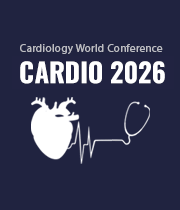Invasive and Non Invasive Cardiology
Invasive cardiology involves diagnostic and therapeutic procedures that require the insertion of catheters or other instruments into the body, typically through blood vessels or body cavities. This approach allows for direct visualization and intervention in the cardiovascular system. Common invasive cardiology procedures include cardiac catheterization, angioplasty, and stent placement to diagnose and treat conditions such as coronary artery disease and blockages. Invasive techniques often provide more detailed information about the heart and blood vessels, enabling precise interventions. While invasive procedures can be highly effective, they carry inherent risks and may necessitate a recovery period. The expertise of interventional cardiologists is essential in performing these procedures, ensuring accurate diagnoses and appropriate interventions to improve patients' cardiovascular health.

Arthur J Siegel
Massachusetts General Hospital, United States
Sergey Suchkov
N. D. Zelinskii Institute for Organic Chemistry of the Russian Academy of Sciences, Russian Federation
Narendra Kumar
HeartbeatsZ Academy, United Kingdom
Arthur J Siegel
Massachusetts General Hospital, United States
Yong Xiao Wang
Albany Medical Center, United States
Narendra Kumar
HeartbeatsZ Academy, United Kingdom



Title : New recommendations for the prevention of sudden cardiac death in athletes and recreational sports
Sekib Sokolovic, ASA Hospital Sarajevo, Bosnia and Herzegowina
Title : Coronary revascularization in patients with diabetes: Prospects for stenting in patients with type 1 diabetes and coronary artery disease
Mekhman N Mamedov, National Research Center for Therapy and Preventive Medicine, Russian Federation
Title : An adult case of polysplenia syndrome associated with sinus node dysfunction
Apoorva Tripathi, Oxford University Hospitals, United Kingdom
Title : Personalized and precision medicine (PPM) as a unique healthcare model through biodesign-driven translational applications and cardiology-related healthcare marketing to secure the human healthcare and biosafety
Sergey Suchkov, N. D. Zelinskii Institute for Organic Chemistry of the Russian Academy of Sciences, Russian Federation
Title : A unique cell-driven phenomenon in the heart and the promising future of the innovative translational tools to manage cardiac self-renewal and regeneration
Sergey Suchkov, N. D. Zelinskii Institute for Organic Chemistry of the Russian Academy of Sciences, Russian Federation
Title : Young hearts at risk: Hidden cardiovascular damage and the role of social determinants of health among youth with type 1 diabetes in Kenya
Phoebe Wamalwa, Ministry of Health, Kenya